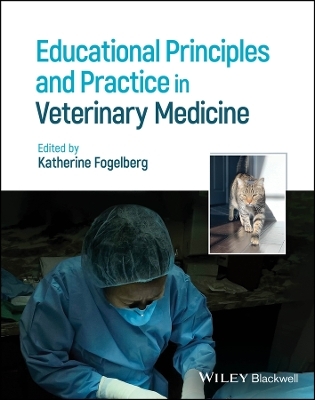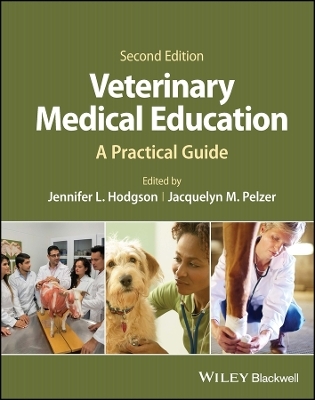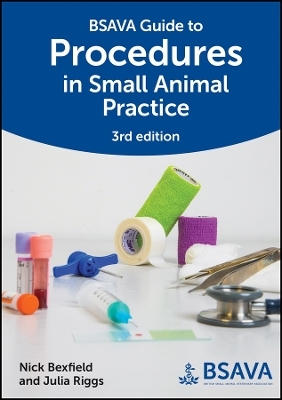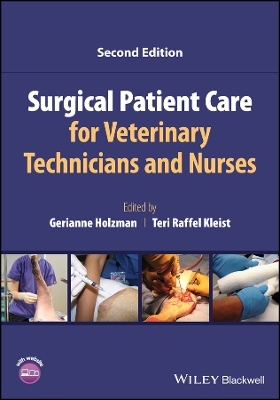
Educational Principles and Practice in Veterinary Medicine
Wiley-Blackwell (Verlag)
978-1-119-85275-9 (ISBN)
»Educational Principles and Practice in Veterinary Medicine« provides a detailed, comprehensive reference to the discipline of education both broadly and as it relates to veterinary medicine. Written for veterinary faculty members, instructors, and educators in other health professions, the book offers an in-depth examination of knowledge and skills related to veterinary education. It discusses all aspects of educational theory, how people learn, the structure and function of higher education, and educational technologies, among many other topics of importance.
Sections cover educational leadership; professional development for faculty; research methods and study design; administration; outcomes and assessment; accreditation; and the roles of the professional program instructor.
»Educational Principles and Practice in Veterinary Medicine« offers veterinary faculty and instructors with a complete resource for understanding the field of education and improving their skills and knowledge.
The editor Katherine Fogelberg, DVM, PhD, MA, is Associate Dean for Professional Programs and Associate Professor, Department of Population Health Sciences, at the Virginia-Maryland College of Veterinary Medicine in Blacksburg, Virginia, USA.
List of Contributors
Preface - Katherine Fogelberg
Chapter 1: Educational philosophy and philosophers
Section 1: Introduction and overview – Katherine Fogelberg and Ying Wang
Section 2: A brief history of Western educational philosophy – Katherine Fogelberg
Section 3: The Eastern Origins of the Philosophy of Education – Ying Wang
Section 4: Ethics and aims of education – Ying Wang
Section 5: Educational philosophers of note – Katherine Fogelberg
Section 6: Teacher-centered educational philosophies: essentialism and perennialism – Ying Wang and Katherine Fogelberg
Section 7: Learner-centered educational philosophies: pragmatism and existentialism – Katherine Fogelberg
Section 8: Socially-centered educational philosophies: behaviorism and reconstructionism – Katherine Fogelberg
Summary
References
Chapter 2: Educational theory and theorists
Section 1: Introduction – Katherine Fogelberg
Section 2: The Big Three and their other sibling – Katherine Fogelberg
Part 1: Positivism: The launching pad for behaviorism and other learning theories
Part 2: Behaviorism: The foundations of outcomes-based education
John B. Watson
Edward Thorndike
B.F. Skinner
Part 3: Cognitivism: Recognition that mental processes matter
Part 4: Constructivism: The student as an active and reflective learner
Jerome Bruner
John Dewey
Maria Montessori
Jean Piaget
Lev Vygotksy (with Kimberly S. Cook)
Section 3: Educational Equity: The classroom as an equalizer – Katherine Fogelberg
Part 1: Gloria Evangelina Anzaldúa – Freyca Berumen-Calderon and Karla O’Donald
Part 2: W.E.B. DuBois – Katherine Fogelberg
Part 3: Paulo Freire – Katherine Fogelberg
Part 4: bell hooks – Katherine Fogelberg
Summary
References
Chapter 3: Cognition and learning - Peter Doolittle and Meghan Byrnes
Section 1: Introduction
Section 2: Social Cognitive Theory
Part 1: Human Agency and Self-Regulation
Part 2: Human Agency and Self-Efficacy
Part 3: Human Agency and Social-Modeling
Part 4: Human Agency and Personal Identity
Part 5: Educational Implications of Social Cognitive Theory
Section 3: Learning, Memory, and Cognition
Part 1: A Framework for Memory and Cognition
Part 2: Conceptual Knowledge
Part 3: Fostering Deep and Flexible Knowledge
Part 4: Multitasking and the Pursuit of Processing
Part 4: Educational Implications of Cognition and Learning
Chapter 4: Andragogy – Katherine Fogelberg
Section 1: Introduction
Section 2: Very brief history of pedagogy
Section 3: History and emergence of andragogy
Section 4: Features and foundations of Knowles’s andragogy
Section 5: Challenges to andragogy
Section 6: Support of andragogy
Section 7: Applications to the veterinary classroom
Summary
References
Chapter 5: Understanding the professional program student
Section 1: introduction and Overview – Bobbi J. Conner
Section 2: Who Are Our Students? – Lawrence Garcia
Section 3: Neurodivergence – Matthew Schexnayder
Section 4: Personality Types – Bobbi J. Conner
Section 5: How Our Students Fit into Our Structures – Lawrence Garcia
Section 6: Expectations – Lawrence Garcia
Section 7: Student Factors – Bobbi J. Conner
Section 8: Practical Tips for Safely Incorporating Failure into Veterinary Education – Bobbi J. Conner
Summary
References
Chapter 6: Roles of the professional program instructor
Section 1: Classroom Learning – Pippa Gibbons
Section 2: Laboratory and Clinical Skills Instruction – Dawn M. Spangler and Lynda M.J. Miller
Section 3: Teaching Personal Finances – Erik Hofmeister
Section 4: Including Cultural Humility, Cultural Competency, and Cultural Fluency in the Veterinary Medical Curriculum – Lisa M. Greenhill, S.M. Polisetti, and Kendall P. Young
Section 5: Teaching Empathy and Ethics – Shelly Wu and Gabriel Huddleston
Section 6: Teaching and Practicing Foundational Communication Skills – Ryane E. Englar
Section 7: Teaching on the Clinical Floor and Training House Officers – Micha C. Simons and Stephanie Thomovsky
Chapter 7: Technology in the classroom
Section 1: Introduction – Shane M. Ryan and Sarah A. Bell
Part1: Learning Management Systems
Part 2: Learning Analytics
Part 3: Learning Tools
Section 2: Presenting Information and Interactions with Content – Shane M. Ryan and Sarah A. Bell
Section 3: Online and Blended Learning – Shane M. Ryan and Sarah A. Bell
Part 1: Online Learning
Part 2: Blended Learning
Section 4: Instructional Systems Design for Digital Learning – Shane M. Ryan and Sarah A. Bell
Section 5: Veterinary Student Success in Technology Enhanced Learning – Shane M. Ryan and Sarah A. Bell
Part 1: Equity and Accessibility Considerations
Part 2: Universal Design for learning
Section 6: Safety and Security Considerations – Shane M. Ryan and Sarah A. Bell
Section 7: Present and Future Technologies to Enhance Learning – Sarah Baillie and Micha C. Simons
Part 1: Common Forms of Educational Technologies
Part 2: Review of Examples of Technologies Used in Veterinary Education
Summary
References
Additional Resources
Chapter 8: The Syllabus – Katherine Fogelberg
Section 1: Introduction
Section 2: Syllabus Purposes
Section 3: Creating an Effective Syllabus
Section 4: The Syllabus as a Tool to Document Scholarship in Teaching and Learning
Summary
References
Additional Resources
Chapter 9: Assignments and Rubrics – Jo Smith
Section 1: Introduction
Section 2: Assignments
Section 3: Rubrics
Part 1: Types of Rubrics
Part 2: Creating Effective Rubrics
Summary
References
Chapter 10: Assessing Student Learning: Exams, Quizzes, and Remediation
Section 1: Formative vs. Summative Assessments and the Role of Evaluations – Kimberly S. Cook and Katherine Fogelberg
Part 1: Introduction
Part 2: Evaluation Overview
Part 3: Evaluation vs. Assessment
Part 4: Components of Evaluation
Section 2: Writing Good Exam Questions – Patricia Butterbrodt
Part 1: Introduction
Part 2: Question Formats
Part 3: The Multiple-Choice Exam
Section 3: Exams and Quizzes: Determining Validity and Reliability – Katrina Jolley
Section 4: Remediation – Malathi Raghavan and Jo R. Smith
Summary
References
Additional Resources
Chapter 11: Assessing clinical skills – Stephanie L. Shaver
Section 1: Introduction
Section 2: Performance Assessment
Section 3: Workplace-Based Assessment
Section 4: Essential Concepts in Clinical Skills Assessment
Summary
References
Chapter 12: Different Approaches to Assessment – Erik Hofmeister
Section 1: Introduction and Approaches
Part 1: Script Concordance Test
Part 2: Extended Matching Questions
Part 3: Individual Readiness Assessment Tests
Part 4: Blogging/Handout
Part 5: Reflections/Journals
Part 6: Image Creation
Part 7: Exam Question Creation
Part 8: Role-Playing
Part 9: Presentations
Part 10: Oral Exams
Part 11: Portfolios
Part 12: Audio and Video Options
Section 2: Implementing New Assignments
Section 3: Novel Grading Schemes
Part 1: Contract Grading
Part 2: Specifications Grading
Part 3: Labor Grading
Part 4: Competency-Based Grading
Part 5: Pass/Fail Grading
Part 6: Ungrading
Section 4: Implementing Novel Grading Schemes
Summary
References
Additional Resources
Chapter 13: Program outcomes
Section 1: Curriculum Mapping – Patricia Butterbrodt
Part 1: Introduction
Part 2: The Two-Level Curriculum Map
Part 3: The Multi-Level Curriculum Map
Part 4: Time and Human Resources Needed
Part 5: Levels of the Map
Part 6: Software for a Curriculum Map
Section 2: Accountability in Assessment Outcomes – Katrina Jolley
Section 3: Ensuring Students Meet Benchmarks for Student Learning – Katrina Jolley
Section 4: Tracking Student Outcomes – Katrina Jolley
Part 1: Individual
Part 2: Cohort
Part 3: Clinical
Part 4: Program
Part 5: Legal Implications for Tracking Outcomes
Summary
References
Chapter 14: Mentoring students
Section 1: Veterinary Student Mentorship - Micha C. Simons and Stephanie Thomovsky
Section 2: Mentoring Students in Veterinary Educational Research – Julie A. Hunt
Section 3: Cheating and Other Unethical Student Behavior – Katrina Jolley
Summary
References
Chapter 15: Educational development – Jesse Watson and Sherry A. Clouser
Section 1: Introduction: Educational Development in Veterinary Education
Section 2: Educator Development
Part 1: From “Faculty Development” to “Educator Development”
Part 2: Educator Development Models in Medical Education
Section 3: Building and Educator Development Program
Part 1: Establish Needs
Part 2: Establish Purpose
Part 3: Define Leadership and Membership
Part 4: Select a Model
Part 5: Select Content Set Learning Objectives / Outcomes
Part 6: Select activities
Section 4: Recommendations for Success
Summary
References
Chapter 16: Documenting teaching for career advancement – Misty R. Bailey and Susan M. Matthew
Section 1: Introduction
Section 2: Structure of This Chapter
Part 1: Teaching
Part 2: Mentoring and Advising
Part 3: Learner Assessment or Outcome Assessment
Part 4: Educational Research and Scholarship
Part 5: Curriculum and Program Development
Part 6: Educational Leadership and Administration
Summary
References
Chapter 17: Educational research
Section 1: Introduction to Educational Research – Jill MacKay
Part 1: When Research Goes Wrong
Part 2: The Replication Crisis: A Primer
Part 3: The Replication Crisis and Open vs. Questionable Research Practices
Section 2: Designing the Educational Research Study – Jill MacKay
Part 1: Ontology, Epistemology, and Reality
Part 2: Methodology
Part 3: Methods
Part 4: An Overview of Key Terminology
Part 5: Study Design
Section 3: Collecting Data – Jill MacKay
Part 1: Research Surveys
Part 2: Research Interviews
Part 3: Focus Groups
Part 4: Recording Behavior
Part 5: Secondary Data
Section 4: Analyzing Data – Jill MacKay
Part 1: Quantitative Analysis
Part 2: Qualitative Analysis
Section 5: The Ethics of Educational Research – Shelly Wu
Part 1: IACUCU vs. IRB
Part 2: CITI Training
Section 6: Reporting the Educational Study – Jill MacKay
Summary
References
Chapter 18: Building Bridges between research and practice – Julie A. Hunt
Section 1: Introduction
Section 2: Educational Theory’s Impact on Educational Research
Section 3: How Educational Research Can Increase Its Impact on Educational Practice
Section 4: Educational Research Challenges
Section 5: Barriers to Changing Educational Methods
Section 6: How Educational Research Has Changed Veterinary Education Practices
Summary
References
Chapter 19: History and purpose of higher education – Donald B. Mills and Kimberly S. Cook
Section 1: Introduction
Section 2: Brief History of Higher Education in the United States
Section 3: Specialized Institutions
Section 4: Students
Section 5: Purpose
Summary
References
Chapter 20: Private and Public Institutions – Kimberly S. Cook and Donald B. Mills
Section 1: Introduction
Section 2: Public Institutions
Part 1: Public Higher Education Funding
Part 2: Governance and Operations Structure
Part 3: Accreditation
Section 3: Private Institutions
Part 1: For Profit
Part 2: Non-profit
Part 3: Funding
Part 4: Governance and Operations Structure
Section 4: Politics and Academic Freedom
Section 5: Organizational Change
Summary
References
Chapter 21: Higher education policies – Patricia Butterbrodt
Section 1: Introduction
Section 2: University Policy Areas
Section 3: Faculty Responsibility to Policy
Summary
References
Chapter 22: Leadership in higher education – Erik Hofmeister
Section 1: Introduction
Section 2: Principles of Leadership
Section 3: Leadership in Education
Section 4: Characteristics of Effective Leaders
Section 5: Incorporating Leadership into the Veterinary Curriculum
Summary
References
Chapter 23: Accreditation
Section 1: Overview – Myrah Stockdale
Section 2: Abbreviated History of Accreditation in the United States – Myrah Stockdale
Section 3: History of Accreditation in Veterinary Education – Malathi Raghavan
Section 4: Accrediting Bodies
Part 1: Overview - Myrah Stockdale
Part 2: Accrediting Agencies – Malathi Raghavan
Section 5: International Accreditation – Malathi Raghavan
Section 6: Accreditation of Veterinary Education Worldwide – Malathi Raghavan
Part 1: United Kingdom
Part 2: Europe
Part 3: Australia and New Zealand
Part 4: Mexico
Part 5: Asia
Part 6: South Africa
Part 7: Brazil
Part 8: In the Absence of Accreditation
Section 7: The Process of Accreditation
Part 1: Overview – Myrah Stockdale
Part 2: First-time Accreditation – Stacy Anderson
Part 3: Expanding the Accreditation Cycle – Myrah Stockdale
Part 4: Project Cycles – Myrah Stockdale
Section 8: Additional Considerations
Part 1: Distributive Models – Stacy Anderson
Part 2: Developing a Quick Reference Guide – Myrah Stockdale
Summary
References
Additional Resources
Appendix
Chapter 24: Leaving thoughts and the future of veterinary education – Katherine Fogelberg
Section 1: Introduction
Section 2: The Power of Veterinary Medical Education
Section 3: Moving Veterinary Education Forward
Section 4: Conclusion and Leaving Thoughts
References
Index
| Erscheinungsdatum | 21.02.2024 |
|---|---|
| Verlagsort | New York |
| Sprache | englisch |
| Gewicht | 1315 g |
| Einbandart | gebunden |
| Themenwelt | Veterinärmedizin |
| ISBN-10 | 1-119-85275-7 / 1119852757 |
| ISBN-13 | 978-1-119-85275-9 / 9781119852759 |
| Zustand | Neuware |
| Informationen gemäß Produktsicherheitsverordnung (GPSR) | |
| Haben Sie eine Frage zum Produkt? |
aus dem Bereich


